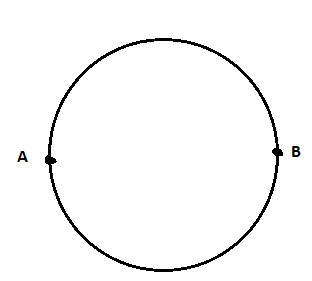Question
Question: A wire of resistance \(12\) ohms per meter is bent to form a complete circle of radius \(10\,{\text{...
A wire of resistance 12 ohms per meter is bent to form a complete circle of radius 10cm. The resistance between its two diametrically opposite points, A and B as shown in the figure, is:

A. 6Ω
B. 0.6Ω
C. 3Ω
D. 6πΩ
Solution
First of all, we will find out the circumference of the circular wire loop and then will find the total resistance of the loop. The two halves of the circular wire seem to be connected in parallel. We will manipulate accordingly to obtain the result.
Complete step by step answer:
In the given solution, we are supplied with the following data:
The resistance of the wire is given as 12 ohms per meter.
It is bent to form a complete circle.
The radius of the circle is 10cm .
We are asked to find out the resistance between the two diametrically opposite points.
To begin with, we will first find the total resistance of the wire. For this we need to find the circumference of the circular wire.
We will now find the circumference of the wire by applying the formula:
C=2πr …… (1)
Where,
C indicates the circumference of the wire.
r indicates the radius of the wire.
For this, first we will convert the unit of the radius which is given in the C.G.S system, to the S.I system.
We know,
1cm=10−2m
So,
10\,{\text{cm}} = 10 \times {10^{ - 2}}\,{\text{m}} \\\
10\,{\text{cm}} = 0.1\,{\text{m}} \\\
Now, we substitute the required values in the equation (1), we get:
C = 2\pi r \\\
\implies C = 2 \times \pi \times 0.1 \\\
\implies C = 0.2\pi \\\
Therefore, the circumference of the circular wire is 0.2π .
Now we need to find the total resistance of the wire, so we will do the following:
We will multiply the resistance per unit length and the total length to find the total resistance of the wire.
R = 12 {\Omega }{{\text{m}}^{ - 1}} \times 0.2\,\pi {\text{m}} \\\
R = 2.4\pi {\Omega } \\\
Therefore, the total resistance of the wire is found to be 2.4πΩ .
But when we take the diametrically opposite points then the whole circular wire will be divided into two parts of equal resistance.
So, resistance of each part is:
{R_1} = {R_2} = \dfrac{{2.4\pi {\Omega }}}{2} \\\
{R_1} = {R_2} = 1.2\pi {\Omega } \\\
Since, these two parts are parallel about the diameter, so we will apply the formula of equivalent resistance for a parallel connection:
\dfrac{1}{{{\operatorname{R} _{{\text{eq}}}}}} = \dfrac{1}{{{R_1}}} + \dfrac{1}{{{R_2}}} \\\
\dfrac{1}{{{\operatorname{R} _{{\text{eq}}}}}} = \dfrac{1}{{1.2\pi }} + \dfrac{1}{{1.2\pi }} \\\
\dfrac{1}{{{\operatorname{R} _{{\text{eq}}}}}} = \dfrac{2}{{1.2\pi }} \\\
{\operatorname{R} _{{\text{eq}}}} = \dfrac{{1.2\pi }}{2} \\\
Again, we simplify further and we get:
Req=0.6πΩ
Hence, the equivalent resistance between its two diametrically opposite points, A and B is Req=0.6πΩ .
So, the correct answer is “Option B”.
Note:
Many students tend to make mistakes in choosing the type of connection of the resistance. It is indeed a parallel connection as the two resistances will be at same potential, but however the current flow will be divided into the two branches. Again, the common mistake they do is by choosing the resistance per unit length as the total resistance of the wire loop. Don’t get confused between resistance per unit length and only resistance.
